airbag CADILLAC ESCALADE 2017 4.G Owners Manual
[x] Cancel search | Manufacturer: CADILLAC, Model Year: 2017, Model line: ESCALADE, Model: CADILLAC ESCALADE 2017 4.GPages: 354, PDF Size: 3.9 MB
Page 4 of 354
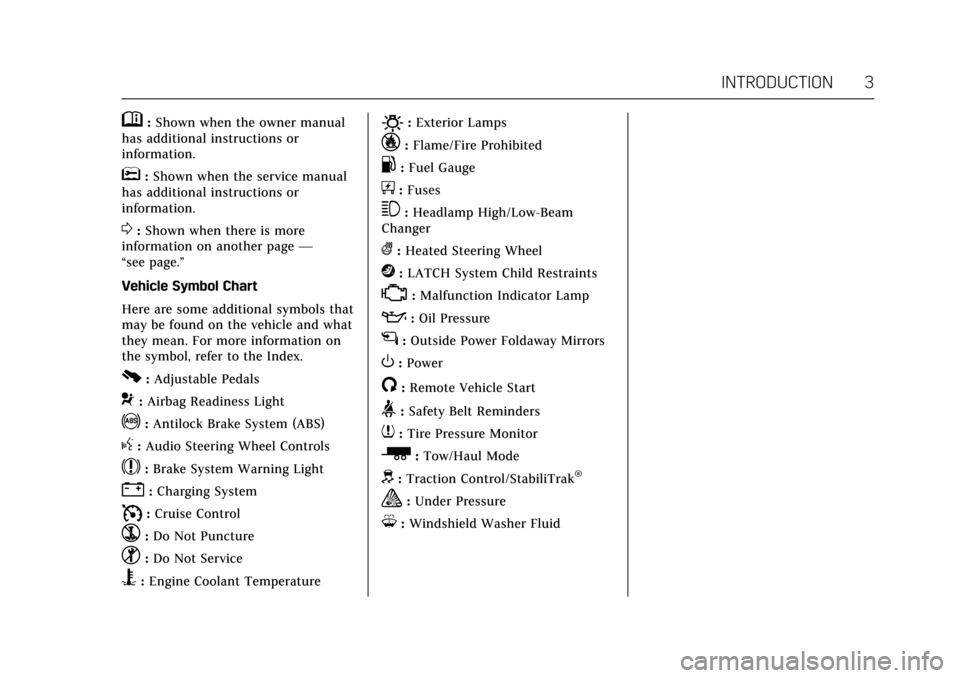
Cadillac Escalade Owner Manual (GMNA-Localizing-MidEast-10293077) -
2017 - crc - 8/24/16
INTRODUCTION 3
M:Shown when the owner manual
has additional instructions or
information.
*: Shown when the service manual
has additional instructions or
information.
0: Shown when there is more
information on another page —
“see page.”
Vehicle Symbol Chart
Here are some additional symbols that
may be found on the vehicle and what
they mean. For more information on
the symbol, refer to the Index.
0: Adjustable Pedals
9:Airbag Readiness Light
!:Antilock Brake System (ABS)
g: Audio Steering Wheel Controls
$:Brake System Warning Light
":Charging System
I: Cruise Control
`:Do Not Puncture
^:Do Not Service
B:Engine Coolant Temperature
O:Exterior Lamps
_:Flame/Fire Prohibited
.:Fuel Gauge
+: Fuses
3:Headlamp High/Low-Beam
Changer
(: Heated Steering Wheel
j:LATCH System Child Restraints
*:Malfunction Indicator Lamp
::Oil Pressure
g:Outside Power Foldaway Mirrors
O:Power
/:Remote Vehicle Start
>:Safety Belt Reminders
7: Tire Pressure Monitor
_:Tow/Haul Mode
d: Traction Control/StabiliTrak®
a:Under Pressure
M: Windshield Washer Fluid
Page 15 of 354
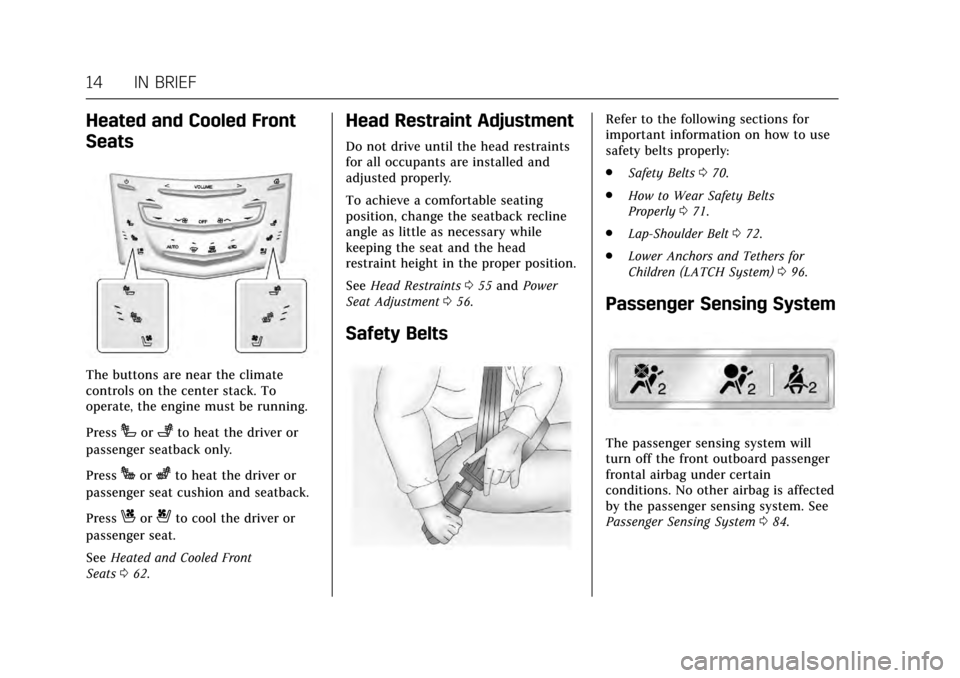
Cadillac Escalade Owner Manual (GMNA-Localizing-MidEast-10293077) -
2017 - crc - 8/24/16
14 IN BRIEF
Heated and Cooled Front
Seats
The buttons are near the climate
controls on the center stack. To
operate, the engine must be running.
Press
Ior+to heat the driver or
passenger seatback only.
Press
Jorzto heat the driver or
passenger seat cushion and seatback.
Press
Cor{to cool the driver or
passenger seat.
See Heated and Cooled Front
Seats 062.
Head Restraint Adjustment
Do not drive until the head restraints
for all occupants are installed and
adjusted properly.
To achieve a comfortable seating
position, change the seatback recline
angle as little as necessary while
keeping the seat and the head
restraint height in the proper position.
See Head Restraints 055 and Power
Seat Adjustment 056.
Safety Belts
Refer to the following sections for
important information on how to use
safety belts properly:
.
Safety Belts 070.
. How to Wear Safety Belts
Properly 071.
. Lap-Shoulder Belt 072.
. Lower Anchors and Tethers for
Children (LATCH System) 096.
Passenger Sensing System
The passenger sensing system will
turn off the front outboard passenger
frontal airbag under certain
conditions. No other airbag is affected
by the passenger sensing system. See
Passenger Sensing System 084.
Page 16 of 354

Cadillac Escalade Owner Manual (GMNA-Localizing-MidEast-10293077) -
2017 - crc - 8/24/16
IN BRIEF 15
The passenger airbag status indicator
will light on the overhead console
when the vehicle is started. See
Passenger Airbag Status
Indicator0129.
Mirror Adjustment
Interior Mirror
Adjustment
Adjust the rearview mirror for a clear
view of the area behind the vehicle.
Automatic Dimming Rearview Mirror
The mirror automatically dims to
reduce the glare of headlamps from
behind. The dimming feature comes
on when the vehicle is started.
Exterior Mirrors
Power Mirrors
To adjust the mirrors:
1. Press (1) or (2) to select the driver or passenger side mirror.
2. Press the arrows on the control pad to move each mirror in the
desired direction.
3. Press either (1) or (2) again to deselect the mirror.
See Power Mirrors 045. Power Folding Mirrors
1. Press{to fold the mirrors
inward.
2. Press
{again to return the
mirrors to the driving position.
Heated Mirrors
If equipped, press
1to heat the
outside mirrors.
See “Rear Window Defogger” under
Dual Automatic Climate Control
System 0173.
Page 55 of 354
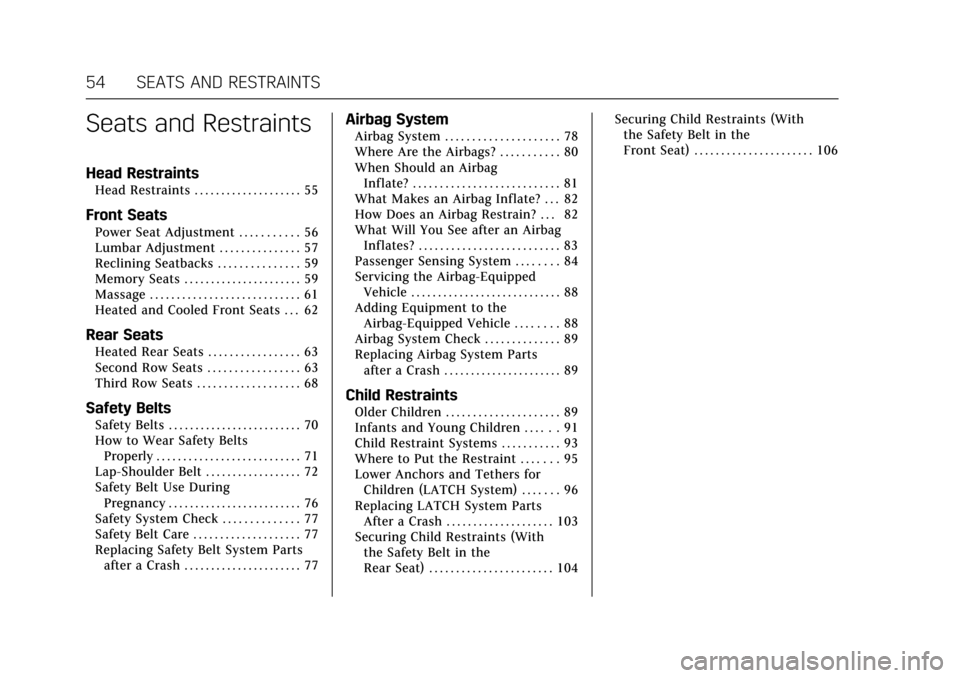
Cadillac Escalade Owner Manual (GMNA-Localizing-MidEast-10293077) -
2017 - crc - 8/24/16
54 SEATS AND RESTRAINTS
Seats and Restraints
Head Restraints
Head Restraints . . . . . . . . . . . . . . . . . . . . 55
Front Seats
Power Seat Adjustment . . . . . . . . . . . 56
Lumbar Adjustment . . . . . . . . . . . . . . . 57
Reclining Seatbacks . . . . . . . . . . . . . . . 59
Memory Seats . . . . . . . . . . . . . . . . . . . . . . 59
Massage . . . . . . . . . . . . . . . . . . . . . . . . . . . . 61
Heated and Cooled Front Seats . . . 62
Rear Seats
Heated Rear Seats . . . . . . . . . . . . . . . . . 63
Second Row Seats . . . . . . . . . . . . . . . . . 63
Third Row Seats . . . . . . . . . . . . . . . . . . . 68
Safety Belts
Safety Belts . . . . . . . . . . . . . . . . . . . . . . . . . 70
How to Wear Safety BeltsProperly . . . . . . . . . . . . . . . . . . . . . . . . . . . 71
Lap-Shoulder Belt . . . . . . . . . . . . . . . . . . 72
Safety Belt Use During
Pregnancy . . . . . . . . . . . . . . . . . . . . . . . . . 76
Safety System Check . . . . . . . . . . . . . . 77
Safety Belt Care . . . . . . . . . . . . . . . . . . . . 77
Replacing Safety Belt System Parts after a Crash . . . . . . . . . . . . . . . . . . . . . . 77
Airbag System
Airbag System . . . . . . . . . . . . . . . . . . . . . 78
Where Are the Airbags? . . . . . . . . . . . 80
When Should an AirbagInflate? . . . . . . . . . . . . . . . . . . . . . . . . . . . 81
What Makes an Airbag Inflate? . . . 82
How Does an Airbag Restrain? . . . 82
What Will You See after an Airbag
Inflates? . . . . . . . . . . . . . . . . . . . . . . . . . . 83
Passenger Sensing System . . . . . . . . 84
Servicing the Airbag-Equipped Vehicle . . . . . . . . . . . . . . . . . . . . . . . . . . . . 88
Adding Equipment to the Airbag-Equipped Vehicle . . . . . . . . 88
Airbag System Check . . . . . . . . . . . . . . 89
Replacing Airbag System Parts after a Crash . . . . . . . . . . . . . . . . . . . . . . 89
Child Restraints
Older Children . . . . . . . . . . . . . . . . . . . . . 89
Infants and Young Children . . . . . . 91
Child Restraint Systems . . . . . . . . . . . 93
Where to Put the Restraint . . . . . . . 95
Lower Anchors and Tethers forChildren (LATCH System) . . . . . . . 96
Replacing LATCH System Parts After a Crash . . . . . . . . . . . . . . . . . . . . 103
Securing Child Restraints (With the Safety Belt in the
Rear Seat) . . . . . . . . . . . . . . . . . . . . . . . 104 Securing Child Restraints (With
the Safety Belt in the
Front Seat) . . . . . . . . . . . . . . . . . . . . . . 106
Page 72 of 354
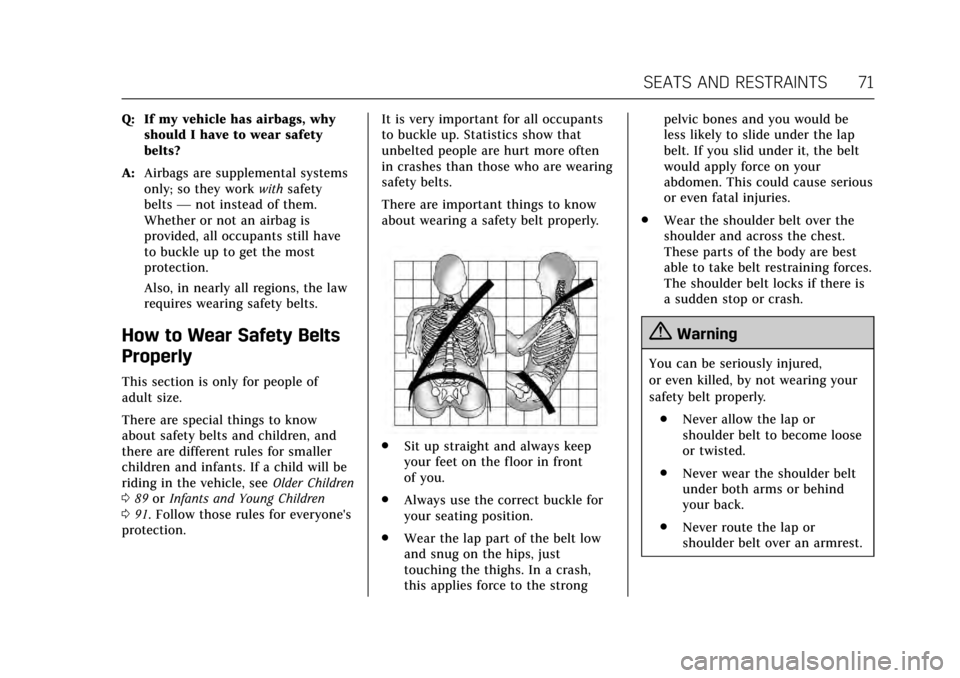
Cadillac Escalade Owner Manual (GMNA-Localizing-MidEast-10293077) -
2017 - crc - 8/24/16
SEATS AND RESTRAINTS 71
Q: If my vehicle has airbags, whyshould I have to wear safety
belts?
A: Airbags are supplemental systems
only; so they work withsafety
belts —not instead of them.
Whether or not an airbag is
provided, all occupants still have
to buckle up to get the most
protection.
Also, in nearly all regions, the law
requires wearing safety belts.
How to Wear Safety Belts
Properly
This section is only for people of
adult size.
There are special things to know
about safety belts and children, and
there are different rules for smaller
children and infants. If a child will be
riding in the vehicle, see Older Children
0 89 orInfants and Young Children
0 91. Follow those rules for everyone's
protection. It is very important for all occupants
to buckle up. Statistics show that
unbelted people are hurt more often
in crashes than those who are wearing
safety belts.
There are important things to know
about wearing a safety belt properly.
.
Sit up straight and always keep
your feet on the floor in front
of you.
. Always use the correct buckle for
your seating position.
. Wear the lap part of the belt low
and snug on the hips, just
touching the thighs. In a crash,
this applies force to the strong pelvic bones and you would be
less likely to slide under the lap
belt. If you slid under it, the belt
would apply force on your
abdomen. This could cause serious
or even fatal injuries.
. Wear the shoulder belt over the
shoulder and across the chest.
These parts of the body are best
able to take belt restraining forces.
The shoulder belt locks if there is
a sudden stop or crash.
{Warning
You can be seriously injured,
or even killed, by not wearing your
safety belt properly.
. Never allow the lap or
shoulder belt to become loose
or twisted.
. Never wear the shoulder belt
under both arms or behind
your back.
. Never route the lap or
shoulder belt over an armrest.
Page 79 of 354
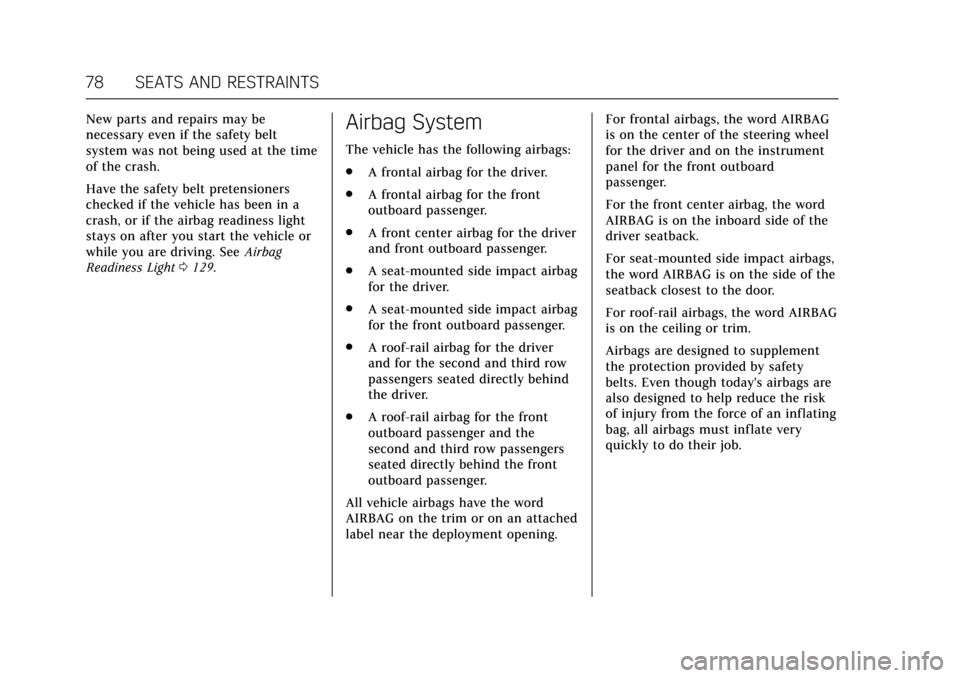
Cadillac Escalade Owner Manual (GMNA-Localizing-MidEast-10293077) -
2017 - crc - 8/24/16
78 SEATS AND RESTRAINTS
New parts and repairs may be
necessary even if the safety belt
system was not being used at the time
of the crash.
Have the safety belt pretensioners
checked if the vehicle has been in a
crash, or if the airbag readiness light
stays on after you start the vehicle or
while you are driving. SeeAirbag
Readiness Light 0129.Airbag System
The vehicle has the following airbags:
.
A frontal airbag for the driver.
. A frontal airbag for the front
outboard passenger.
. A front center airbag for the driver
and front outboard passenger.
. A seat-mounted side impact airbag
for the driver.
. A seat-mounted side impact airbag
for the front outboard passenger.
. A roof-rail airbag for the driver
and for the second and third row
passengers seated directly behind
the driver.
. A roof-rail airbag for the front
outboard passenger and the
second and third row passengers
seated directly behind the front
outboard passenger.
All vehicle airbags have the word
AIRBAG on the trim or on an attached
label near the deployment opening. For frontal airbags, the word AIRBAG
is on the center of the steering wheel
for the driver and on the instrument
panel for the front outboard
passenger.
For the front center airbag, the word
AIRBAG is on the inboard side of the
driver seatback.
For seat-mounted side impact airbags,
the word AIRBAG is on the side of the
seatback closest to the door.
For roof-rail airbags, the word AIRBAG
is on the ceiling or trim.
Airbags are designed to supplement
the protection provided by safety
belts. Even though today's airbags are
also designed to help reduce the risk
of injury from the force of an inflating
bag, all airbags must inflate very
quickly to do their job.
Page 80 of 354
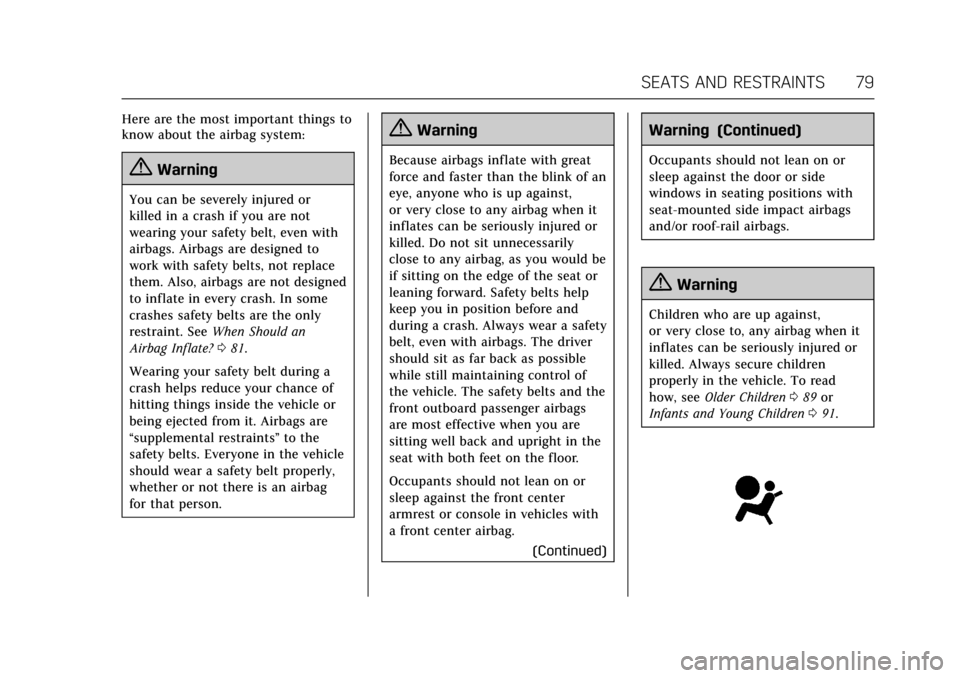
Cadillac Escalade Owner Manual (GMNA-Localizing-MidEast-10293077) -
2017 - crc - 8/24/16
SEATS AND RESTRAINTS 79
Here are the most important things to
know about the airbag system:
{Warning
You can be severely injured or
killed in a crash if you are not
wearing your safety belt, even with
airbags. Airbags are designed to
work with safety belts, not replace
them. Also, airbags are not designed
to inflate in every crash. In some
crashes safety belts are the only
restraint. SeeWhen Should an
Airbag Inflate? 081.
Wearing your safety belt during a
crash helps reduce your chance of
hitting things inside the vehicle or
being ejected from it. Airbags are
“supplemental restraints” to the
safety belts. Everyone in the vehicle
should wear a safety belt properly,
whether or not there is an airbag
for that person.
{Warning
Because airbags inflate with great
force and faster than the blink of an
eye, anyone who is up against,
or very close to any airbag when it
inflates can be seriously injured or
killed. Do not sit unnecessarily
close to any airbag, as you would be
if sitting on the edge of the seat or
leaning forward. Safety belts help
keep you in position before and
during a crash. Always wear a safety
belt, even with airbags. The driver
should sit as far back as possible
while still maintaining control of
the vehicle. The safety belts and the
front outboard passenger airbags
are most effective when you are
sitting well back and upright in the
seat with both feet on the floor.
Occupants should not lean on or
sleep against the front center
armrest or console in vehicles with
a front center airbag.
(Continued)
Warning (Continued)
Occupants should not lean on or
sleep against the door or side
windows in seating positions with
seat-mounted side impact airbags
and/or roof-rail airbags.
{Warning
Children who are up against,
or very close to, any airbag when it
inflates can be seriously injured or
killed. Always secure children
properly in the vehicle. To read
how, seeOlder Children 089 or
Infants and Young Children 091.
Page 81 of 354
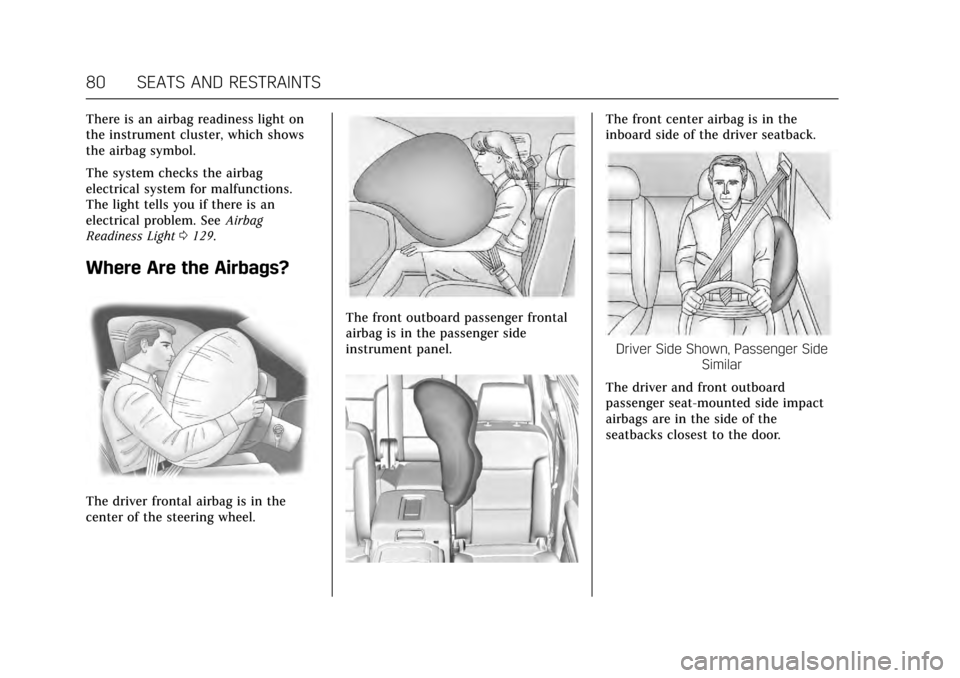
Cadillac Escalade Owner Manual (GMNA-Localizing-MidEast-10293077) -
2017 - crc - 8/24/16
80 SEATS AND RESTRAINTS
There is an airbag readiness light on
the instrument cluster, which shows
the airbag symbol.
The system checks the airbag
electrical system for malfunctions.
The light tells you if there is an
electrical problem. SeeAirbag
Readiness Light 0129.
Where Are the Airbags?
The driver frontal airbag is in the
center of the steering wheel.
The front outboard passenger frontal
airbag is in the passenger side
instrument panel.
The front center airbag is in the
inboard side of the driver seatback.
Driver Side Shown, Passenger Side
Similar
The driver and front outboard
passenger seat-mounted side impact
airbags are in the side of the
seatbacks closest to the door.
Page 82 of 354
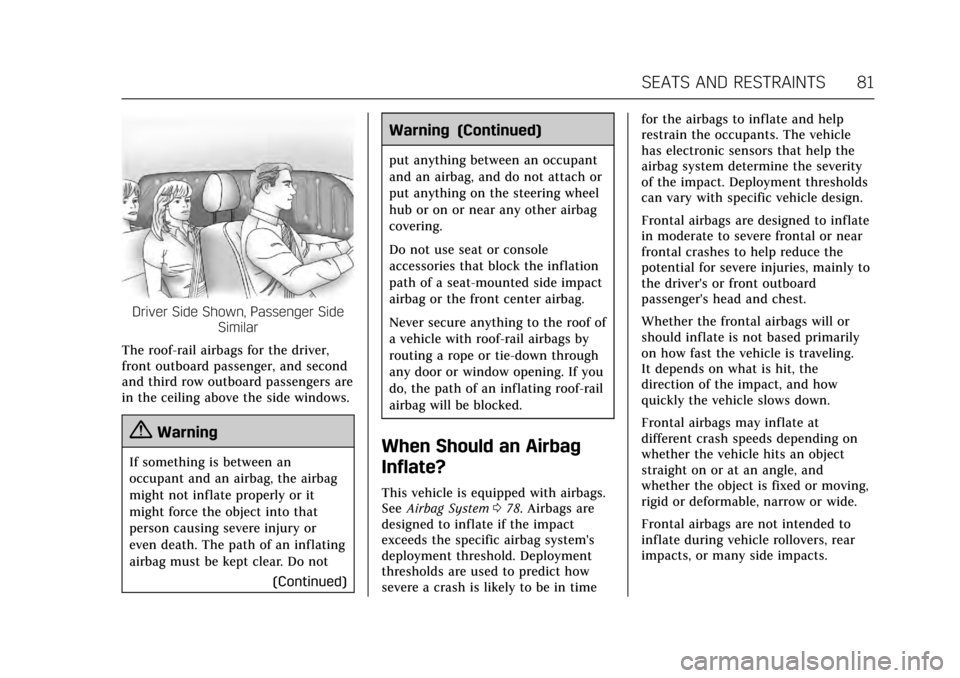
Cadillac Escalade Owner Manual (GMNA-Localizing-MidEast-10293077) -
2017 - crc - 8/24/16
SEATS AND RESTRAINTS 81
Driver Side Shown, Passenger SideSimilar
The roof-rail airbags for the driver,
front outboard passenger, and second
and third row outboard passengers are
in the ceiling above the side windows.
{Warning
If something is between an
occupant and an airbag, the airbag
might not inflate properly or it
might force the object into that
person causing severe injury or
even death. The path of an inflating
airbag must be kept clear. Do not (Continued)
Warning (Continued)
put anything between an occupant
and an airbag, and do not attach or
put anything on the steering wheel
hub or on or near any other airbag
covering.
Do not use seat or console
accessories that block the inflation
path of a seat-mounted side impact
airbag or the front center airbag.
Never secure anything to the roof of
a vehicle with roof-rail airbags by
routing a rope or tie-down through
any door or window opening. If you
do, the path of an inflating roof-rail
airbag will be blocked.
When Should an Airbag
Inflate?
This vehicle is equipped with airbags.
SeeAirbag System 078. Airbags are
designed to inflate if the impact
exceeds the specific airbag system's
deployment threshold. Deployment
thresholds are used to predict how
severe a crash is likely to be in time for the airbags to inflate and help
restrain the occupants. The vehicle
has electronic sensors that help the
airbag system determine the severity
of the impact. Deployment thresholds
can vary with specific vehicle design.
Frontal airbags are designed to inflate
in moderate to severe frontal or near
frontal crashes to help reduce the
potential for severe injuries, mainly to
the driver's or front outboard
passenger's head and chest.
Whether the frontal airbags will or
should inflate is not based primarily
on how fast the vehicle is traveling.
It depends on what is hit, the
direction of the impact, and how
quickly the vehicle slows down.
Frontal airbags may inflate at
different crash speeds depending on
whether the vehicle hits an object
straight on or at an angle, and
whether the object is fixed or moving,
rigid or deformable, narrow or wide.
Frontal airbags are not intended to
inflate during vehicle rollovers, rear
impacts, or many side impacts.
Page 83 of 354
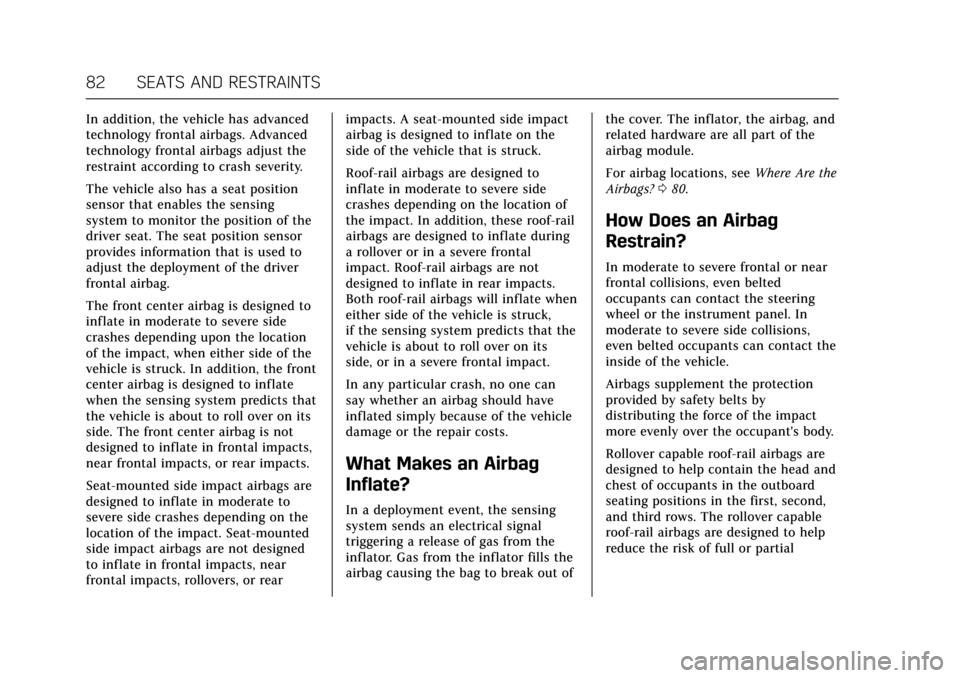
Cadillac Escalade Owner Manual (GMNA-Localizing-MidEast-10293077) -
2017 - crc - 8/24/16
82 SEATS AND RESTRAINTS
In addition, the vehicle has advanced
technology frontal airbags. Advanced
technology frontal airbags adjust the
restraint according to crash severity.
The vehicle also has a seat position
sensor that enables the sensing
system to monitor the position of the
driver seat. The seat position sensor
provides information that is used to
adjust the deployment of the driver
frontal airbag.
The front center airbag is designed to
inflate in moderate to severe side
crashes depending upon the location
of the impact, when either side of the
vehicle is struck. In addition, the front
center airbag is designed to inflate
when the sensing system predicts that
the vehicle is about to roll over on its
side. The front center airbag is not
designed to inflate in frontal impacts,
near frontal impacts, or rear impacts.
Seat-mounted side impact airbags are
designed to inflate in moderate to
severe side crashes depending on the
location of the impact. Seat-mounted
side impact airbags are not designed
to inflate in frontal impacts, near
frontal impacts, rollovers, or rearimpacts. A seat-mounted side impact
airbag is designed to inflate on the
side of the vehicle that is struck.
Roof-rail airbags are designed to
inflate in moderate to severe side
crashes depending on the location of
the impact. In addition, these roof-rail
airbags are designed to inflate during
a rollover or in a severe frontal
impact. Roof-rail airbags are not
designed to inflate in rear impacts.
Both roof-rail airbags will inflate when
either side of the vehicle is struck,
if the sensing system predicts that the
vehicle is about to roll over on its
side, or in a severe frontal impact.
In any particular crash, no one can
say whether an airbag should have
inflated simply because of the vehicle
damage or the repair costs.
What Makes an Airbag
Inflate?
In a deployment event, the sensing
system sends an electrical signal
triggering a release of gas from the
inflator. Gas from the inflator fills the
airbag causing the bag to break out of
the cover. The inflator, the airbag, and
related hardware are all part of the
airbag module.
For airbag locations, see
Where Are the
Airbags? 080.
How Does an Airbag
Restrain?
In moderate to severe frontal or near
frontal collisions, even belted
occupants can contact the steering
wheel or the instrument panel. In
moderate to severe side collisions,
even belted occupants can contact the
inside of the vehicle.
Airbags supplement the protection
provided by safety belts by
distributing the force of the impact
more evenly over the occupant's body.
Rollover capable roof-rail airbags are
designed to help contain the head and
chest of occupants in the outboard
seating positions in the first, second,
and third rows. The rollover capable
roof-rail airbags are designed to help
reduce the risk of full or partial